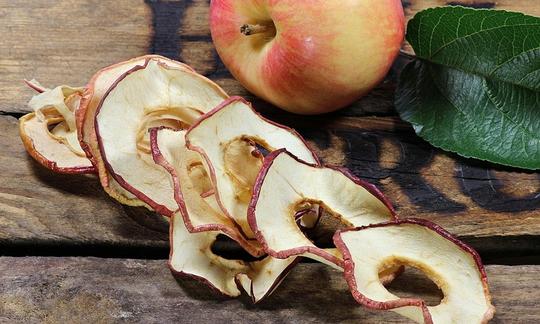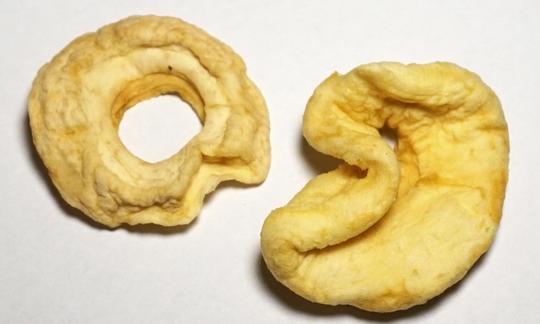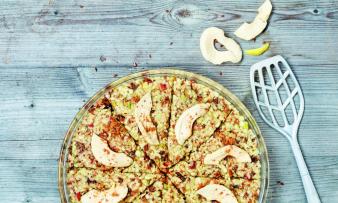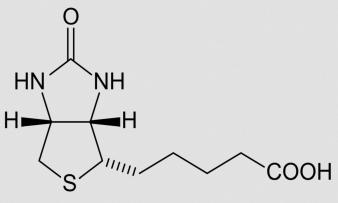Table of contents
Dried or dehydrated apples ( apple rings or apple slices / apple wedges / apple chips), especially in unsulfured form, are a healthy snack for in-between meals. They contain many vitamins and minerals, but also sugar.
Use in the kitchen:
Dried apple rings are ideal as a small snack or to enhance breakfast, e.g. in porridge or muesli ( Erb-Müesli). Consumption leads to a slow rise in blood sugar and the high content of micronutrients makes them a good source of energy during endurance sports. 1
Depending on the type of apple, dried apples taste either particularly sweet or slightly sour. Fresh apples are a good base: sweet and sour apples such as the Elstar, Boskoop, Jonagold and Granny Smith varieties, or sweet varieties such asGala, Braeburn and Golden Delicious. But you can use all varieties for drying, even old orchard varieties, provided they are not fully ripe. A gentle drying process is important so that the vitamins contained in the apple are retained. The term apple chips usually also refers to dried apple rings, i.e. they are not apple slices fried in fat. The crispy varieties must be dried at higher temperatures (around 70 °C) - but then they are no longer raw. If you want, you can also sprinkle spices (e.g. ground cinnamon) on the apple chips to refine them.
When dried, apples turn a brownish color. This is different with sulfurized apple rings, which do not turn brown. However, sulfur is not necessary for better taste; it is mainly used for appearance and better shelf life. Alternatively, you can sprinkle the sliced apple rings or slices with a little lemon juice.
Drying in hot air, also known as dehydration, is one of the oldest methods of preservation. It used to be used to preserve summer fruit for the winter. Pome fruits, such as apples or pears, stone fruits, dates or figs, are particularly common as dried fruit.
Vegan recipe for raw apple cinnamon balls:
Ingredients: 115 g cashews (alternatively, other nuts will work, e.g. walnuts), 60 g almonds, 140 g dates, 80 g dried apples, 1 tsp ground cinnamon, 1 tsp chia seeds, 6 tbsp puffed amaranth, 1 tsp lemon juice.
Preparation: Put the nuts in a blender or food processor and mix on the highest setting. The mixture may still be a bit chunky. Add the remaining ingredients and knead with the food processor until a sticky mass is formed. Now form small balls with wet hands and roll them in puffed amaranth, cocoa powder or coconut flakes, for example. Keep cool until ready to eat.
| Not only vegans or vegetarians should read this: Vegans often eat unhealthily. Avoidable nutritional errors. |
Shopping - where to buy?
The food trade offers various industrially produced apple rings. You can often find them in autumn in supermarkets such as Coop, Migros, Denner, Volg, Spar, Aldi, Lidl, Rewe, Edeka, Hofer etc. The dried apple rings available in stores are usually sulphurized (e.g. sulphur dioxide). This means they keep a light colour, their shelf life is extended and microorganisms do not multiply on them. It is therefore better to buy organically produced dried apples or, if possible, dry them yourself. Organic apple slices are definitely available in organic supermarkets ( Denn's Biomarkt, Alnatura), organic shops or health food stores.
Since many dried fruits - including apples - come from Asia, America or Australia, it is important to always pay attention to the country of origin.
Homemade preparation:
To make dried apple rings or apple slices, you use ripe, if possible organically produced, regional apples that you first clean and core. For apple rings, you need an apple corer, with which you can remove the core in a round shape in one go. You can then peel them according to your personal taste and then cut them into rings or slices. 1 However, the best secondary plant substances are in and directly under the peel. You can make even faster progress with a vegetable slicer and the slices or rings will be the same thickness. This is because the thickness is crucial for the length of the drying process. The apple slices should always be thinner than 2 mm.
When are dried apple rings ready? They should feel dry and no longer have any surface moisture. Immediately after drying, you should be able to break the pieces with your fingers. They often absorb some moisture again afterwards and the consistency becomes tougher again. If you want to make crispy apple chips, you have to use particularly thin slices and dry them a little longer or increase the temperature.
Drying takes place in special drying devices, in the oven (convection) with the door slightly open or in the microwave. The drying temperatures are between 40 and 70 °C. At high temperatures, however, the dried goods lose their taste and aroma more quickly. Temperatures above 40 °C can reduce certain vitamins, but long drying times can also reduce the vitamin C content through oxidation, for example. Apple slices dried at 40-50 °C are most likely to be of raw food quality.
If you have a dehydrator, place the thinly sliced apple rings or apple slices next to each other on the drying sieves. Make sure that the apple slices do not touch each other, as they will stick together later. It is advisable to change the sieves again and again during the drying process so that the apples dry evenly. With a dehydrator, you can set the temperature precisely and the different models usually have their own instructions (length and temperature) for each type of fruit. Dehydrators are also very energy efficient, as fruit needs many hours to dry. At around 42 °C, drying time is 6-8 hours.
If you don't have one of these devices, you can still use an oven with a convection function. To do this, place the thinly sliced apples on wire racks and put them in the oven. Instead of a single wire rack, you can also use a normal baking tray with baking paper. Turn the apple rings over after about 2 hours so that they don't stick so firmly to the baking paper, and rotate the tray so that they dry better on the other side. It is also more energy-efficient to put several trays in the oven at once. When drying in the oven, it is very important that a small gap is left open so that the moisture can escape. You will often find instructions with drying temperatures of 70 °C (2-3 hours). If you want to dry as gently as possible, we recommend temperatures of 40-50 °C. If you cannot regulate the temperature of the oven precisely below 50 °C, it is advisable to set the oven to the lowest setting (usually starts before 50 °C, but without a display). Heat also escapes through the open gap and you can assume that the temperature will be reduced a little as a result. The drying time in the oven is also around 6-8 hours, depending on whether you want a crispy or soft result.
If there is sufficient sunlight, you can also dry the fruit outdoors on a drying rack or on an air-permeable surface (cotton gauze or gauze). However, it is very difficult to control the temperature in direct sunlight. Depending on the weather, this method takes at least 2 to 7 days. Alternatively, you can also dry apple rings over the heater.
Although it is possible to make dried apple rings in the microwave, we do not recommend this method. On the one hand, this method will definitely lose all the vitamins and healthy ingredients, and on the other hand, you will only get a few apple rings from the microwave.
From ten kg of fresh apples you get about one kg of apple rings if they are properly dried. 1
Industrial production:
When processing organic apple rings, no sulphur is used to preserve the colour or to prevent sugaring. There is also no fumigation with methyl bromide to keep pests away, or with sorbic acid as a preservative. Shock freezing and storage at around -34 °C for a few days is usually sufficient to kill pests. Pest eggs are destroyed in special pressure chambers with CO 2. There are very strict controls against moulds and aflatoxins in the organic sector. 2
In order to obtain so-called "soft fruits", the dried fruits are artificially treated with a bath of steam. However, the nutrients suffer much more as a result than if they were simply eaten dried. 2
Drying systems such as drying cabinets are also used in industrial production. These condensation dryers work with an air dehumidification process, as is also common in laundry drying. Vacuum dryers remove 70-80% of the water content. This process is very gentle on vitamins and minerals, but is particularly expensive and difficult to operate. 3
Storage:
Really well dried apple rings can be kept for several weeks to months. Screw-top jars, cans or other sealable containers are suitable for storing the dried apple rings. In any case, they should be stored in a dark, cool and airtight place.
Ingredients - nutritional value - calories:
The apple consists of 85% water and is one of the low-calorie fruits with around 52 kcal/100g. In dried form, the calorie count rises to 243 kcal/100g, of which around 57% is sugar. The remaining moisture is around 30%. A fresh apple is very healthy and contains an average of over 30 vitamins and trace elements. Many valuable minerals are found in and directly under the peel.
Do dried apples still contain vitamins? By gently removing the water, minerals and trace elements are largely retained and are more concentrated. This concentration is what gives dried apples their intense taste.
Dried apples contain around 450 mg/100g of potassium, which is comparable to peeled barley or jackfruit. Sun-dried tomatoes (3,427 mg/100g) and dried spices such as coriander leaves (4,466 mg/100g) have particularly high potassium levels. Potassium regulates the osmotic pressure in the cells and has a balancing effect on the water balance. 4
Vitamin B2 is also well represented in dried apples at 0.16 mg/100g. Oat flakes and tomato paste have similar values; yeast flakes have significantly more at 4 mg/100g. Riboflavin is a heat-resistant but light-sensitive, water-soluble vitamin that is involved in many important metabolic processes in our body. 4
Dried apples contain 1.4 mg of iron per 100g. This content is identical to that of dried sour cherries and Brussels sprouts. Dried spices contain significantly more iron, although we don't eat a lot of them. Except in special dishes with a lot of sweet paprika powder (approx. 24 mg per 100g) or curry powder (19 mg iron per 100g). This trace element is of central importance for oxygen transport in the blood and also for its storage in the cells. 4
Thanks to gentle drying, there is also no great loss of vitamin C content : dried apples have about 3.9 mg/100g and fresh apples contain about 4.6 mg/100g of ascorbic acid. 4
The complete ingredients, the coverage of the daily requirement and comparison values with other ingredients can be found in our nutrient tables. In the article Nutrients explained you will get a detailed insight into the topic. CLICK FOR before the text.
Health aspects - effects:
Are dried apples healthy? Dried fruit is good for the digestive tract due to its high fiber content and keeps you full longer than other snacks. It helps to optimize intestinal activity. However, compared to fresh fruit, blood sugar rises more quickly (see next chapter).
Eating 75 g of dried apples daily can significantly improve blood lipid levels within 6 months and thus protect against cardiovascular disease. A study showed that with regular consumption, "bad" cholesterol (LDL) decreases and "good" cholesterol (HDL) increases. A positive side effect of this study was that the subjects lost weight. 5
Apples contain many secondary plant substances with antioxidant and anti-cancer properties. There are studies that show that regular consumption of apples reduces the risk of developing chronic diseases such as cardiovascular disease, cancer and asthma. The phytochemical concentrations vary greatly between varieties; storage is not necessarily the decisive factor here, but processing (e.g. into juice) can greatly reduce the phenols contained. 6 In addition, the peel of an apple has been shown to contain higher concentrations of polyphenols than the flesh of the fruit. 7
Dangers - Intolerances - Side effects:
If consumed in excess, dried or dehydrated apples (and other dried fruits) can lead to flatulence or have a laxative effect. 8 This is because the small intestine is quickly overwhelmed by a large amount of fructose, which is why some of the fructose reaches the large intestine. Fructose serves as a source of nutrients for the bacteria living there in the large intestine, which leads to the production of gases and acids. Many people react to this with diarrhea and flatulence.
The fruit sugar itself is by no means harmful for healthy people. However, due to its high sweetening power, fructose is often found in concentrated form in fruit gums, ice cream pralines, chocolate bars, store-bought cakes, etc. Excessive fructose consumption leads to fructose malabsorption (poor absorption). In the case of fructose intolerance (FI), even small amounts of fructose from fruit or vegetables can cause problems. 9,10
The sulphur often used in the production of dried fruit destroys the B vitamins (especially vitamin B1 and folic acid) and can also lead to skin allergies in sensitive people or respiratory problems in asthmatics. 8
Some producers also use floured conveyor belts to prevent the fruit from sticking together. Therefore, people with gluten intolerance should pay attention to accurate labeling.
The fruit's own sugar causes blood sugar levels to rise much more slowly than is the case with table sugar. However, fresh fruit causes blood sugar levels to rise even more slowly. Dried fruit is therefore only moderately suitable for diabetics.
General information:
Apple trees belong to the pome fruit family within the rose family (Rosaceae). The cultivated apple ( Malus domestica, syn. Pyrus malus) is the best known and economically most important species of the genus Malus worldwide. The fruit does not develop from the ovary, but from the flower axis, which is why they are referred to as false fruits. As climacteric plants, apples continue to ripen after harvest. The apple owes its aroma to the substances that are made up of esters, aldehydes and alcohols, which can vary greatly depending on the variety. You can find detailed information about apples under the ingredient apple, raw, with peel.
Alternative names:
Dried apple rings are called dried apple rings and apple pieces are called dried apple slices.
Keywords for use:
According to Wikipedia, apple rings can be seasoned in many different ways. In addition to the sweet version with cinnamon and sugar or with liquid chocolate, there is also the savory version (with green peppers marinated in vinegar). Apple rings can also be eaten baked in batter or deep-fried.
Fruit gum is also known as "apple rings". These green and white, ring-shaped gummy candies do not contain any natural apple flavor. They are made up of: sugar, glucose syrup, gelatin, acidifiers, flavors and colorings.
Literature - Sources:
Bibliography - 10 Sources (Link to the evidence)
| 1. | Verbraucherservice Bayern.de Trockenfrüchte - nährstoffreich und lecker. |
| 2. | Pini U. Das Bio-Food Handbuch. Ullmann: Hamburg, Potsdam. 2014. |
| 3. | Dietrich R, Krotschek C, Schwärzler G. Optimierung Dehydratisierungstechnologie. BMVIT Berichte aus Energie- und Umweltforschung. 2004;25. |
| 4. | USDA United States Department of Agriculture. |
| 5. | Chai SC, Hooshmand S et al. Daily Apple versus Dried Plum: Impact on Cardiovascular Disease Risk Factors in Postmenopausal Women. Journal of the Academy of Nutrition and Dietetics. 2012;112(8). |
| 6. | Boyer J, Hai Liu R. Apple phytochemicals and their health benefits. Nutritional Journal. 2004;3(5). |
| 7. | Tsao R, Yang R et al. Polyphenolic Profiles in Eight Apple Cultivars Using High-Performance Liquid Chromatography (HPLC). J. Agric. Food Chem. 2003;51(21). |
| 8. | Apotheken-umschau-trockenobst.de Gesund oder Kalorienbombe? |
| 9. | Gibson PR, Newnham E et al. Review article: fructose malabsorption and the bigger picture. Aliment Pharmacol Ther. 2007 Feb 15;25(4):349-63. DOI: 10.1111/ j.1365-2036.2006.03186.x |
| 10. | Tran C. Inborn Errors of Fructose Metabolism. What Can We Learn from Them? Nutrients. 2017 Apr; 9(4): 356. DOI: 10.3390/nu9040356 |












Comments